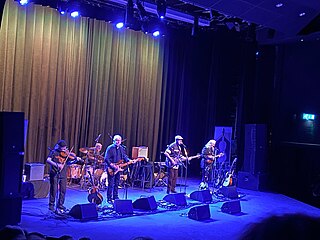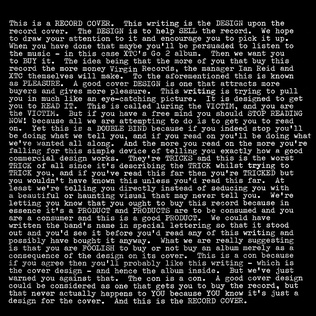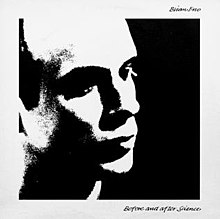
David James Mattacks is an English rock and folk drummer, best known for his work with British folk rock band Fairport Convention.

Fairport Convention are an English folk rock band, formed in 1967 by guitarists Richard Thompson and Simon Nicol, bassist Ashley Hutchings and drummer Shaun Frater. They started out influenced by American folk rock, with a set list dominated by Bob Dylan and Joni Mitchell songs and a sound that earned them the nickname "the British Jefferson Airplane". Vocalists Judy Dyble and Iain Matthews joined them before the recording of their self-titled debut in 1968; afterwards, Dyble was replaced by Sandy Denny, with Matthews later leaving during the recording of their third album.

Another Green World is the third solo studio album by Brian Eno, released by Island Records on 14 November 1975. The album marked a transition from the rock-based music of Eno's previous releases toward the minimalist instrumentals of his late 1970s ambient work. Only five of its fourteen tracks feature vocals, a contrast with his previous vocal albums.

Commercial Album is an album released by art rock group the Residents in 1980. It is commonly considered a follow-up to their 1978 album Duck Stab/Buster & Glen, in that it retains the former album's pop-oriented song structures. The album contains 40 songs, each lasting exactly one minute - a deliberate allusion to Top 40 mainstream radio. The album's liner notes state that, to form a complete pop song, tracks from the album should be played three times in a row.

Jeremy Webster "Fred" Frith is an English multi-instrumentalist, composer, and improviser.

Taking Tiger Mountain (By Strategy) is the second solo studio album by Brian Eno (mononymously credited as "Eno"), released in November 1974 by Island Records. Unlike his debut album Here Come the Warm Jets, which had featured 16 musicians, this album utilized a core band of five instrumentalists: Eno himself on keyboards and guitar, guitarist Phil Manzanera, bassist Brian Turrington, drummer Freddie Smith, and percussionist Robert Wyatt, and also featured far fewer guests. Manzanera, who had played with Eno in Roxy Music, also participated in the writing and production. To help guide the musicians, Eno and Peter Schmidt developed instruction cards called Oblique Strategies to facilitate creativity during the recording process.

Here Come the Warm Jets is the debut solo album by Brian Eno, released on Island Records on 8 February 1974. It was recorded and produced by Eno following his departure from Roxy Music, and blends glam and pop stylings with avant-garde approaches. The album features numerous guests, including several of Eno's former Roxy Music bandmates along with members of Hawkwind, Matching Mole, Pink Fairies, Sharks, Sweetfeed, and King Crimson. Eno devised unusual methods and instructions to coax unexpected results from the various musicians.

Original Soundtracks 1 is a studio album recorded by rock band U2 and Brian Eno under the pseudonym Passengers as a side project. Released on 6 November 1995, the album is a collection of songs written for mostly imaginary films. Owing to Eno's involvement as a full songwriting partner and the album's experimental nature, the moniker "Passengers" was chosen to distinguish it from U2's conventional albums. It was commercially unnoticed by the band's standards and received generally mixed reviews. Guest musicians on the record included Italian opera singer Luciano Pavarotti and producer Howie B, who would co-produce U2's following album, Pop (1997).

For Your Pleasure is the second studio album by the English rock band Roxy Music, released on 23 March 1973 by Island Records. It was their last to feature synthesiser and sound specialist Brian Eno.

The Shadows were an English instrumental rock group, who dominated the British popular music charts in the late 1950s and early 1960s, in the pre-Beatles era. They served as the backing band for Cliff Richard from 1958 to 1968, and have joined him for several reunion tours.

Go 2 is the second studio album by the English band XTC, released 6 October 1978 on Virgin Records. The United Kingdom version contained no singles, but the American and Canadian versions included the single "Are You Receiving Me?" released on 27 October 1978 along with a music video produced for the song.

"With or Without You" is a song by Irish rock band U2. It is the third track on their fifth studio album, The Joshua Tree (1987), and was released as the album's lead single on 16 March 1987. The song was the group's most successful single at the time, becoming their first number-one hit in both the United States and Canada by topping the Billboard Hot 100 for three weeks and the RPM national singles chart for one week, with a further three weeks at number two.

Music for Films is the seventh solo studio album by Brian Eno, released in September 1978 on EG Records. His third release of experimental electronic material, it is a conceptual work intended as a soundtrack for imaginary films, although many of the pieces had already appeared in actual films. It charted at #55 on the UK.

Gravity is a 1980 solo album by English guitarist and composer Fred Frith. It was Frith's second solo album, and his first since Henry Cow disbanded in 1978. It was originally released in the United States on the Residents' Ralph Records, as the first of three solo albums Frith would record for the label. Gravity has been described as an avant-garde "dance" record that draws on rhythm and dance from folk music across the world.

Paul Fraser Rudolph is a Canadian guitarist, bassist, singer, and cyclist. He made his mark in the UK underground music scene, and then as a session musician, before returning to Canada to indulge his passion for cycling. He resided in Gibsons, British Columbia, where he owned and operated a bicycle business, Spin Cycle. He has since retired to Victoria, British Columbia.

"Make It wit Chu" is the third single by Queens of the Stone Age from their 2007 album Era Vulgaris.
"Baby's on Fire" is the third track on English musician Brian Eno's 1974 debut solo album Here Come the Warm Jets.
"Slug" is a song by Passengers, a side project of rock band U2 and musician Brian Eno. It is the second track on Passengers' only release, the 1995 album Original Soundtracks 1. The track was originally titled "Seibu" and was almost left off the album before it was rediscovered later during the recording sessions. Though Eno made most of the creative decisions during the recording sessions, "Slug" was one of the few tracks that the members from U2 tried to craft themselves.

Someday World is a collaboration album by British musician Brian Eno and Karl Hyde, of British electronic group Underworld, released on 5 May 2014. The album features a number of supporting musicians, including Coldplay's Will Champion, John Reynolds, and Andy Mackay of Roxy Music, and was produced by Brian Eno with 20-year-old Fred Gibson. It was followed two months later by the album High Life.
"Third Uncle" is a 1974 song by the English musician Brian Eno, released on his second solo album Taking Tiger Mountain . The song was recorded at Basing Street Studios in Notting Hill, London, in September 1974, and produced by Eno. It has been highly influential and covered by many artists, most notably by Bauhaus in 1982.

















